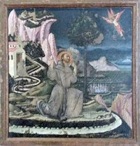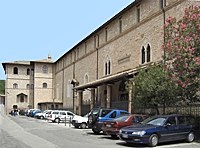
The first nunnery on the site, which belonged to the Trinci family, was built in 1327 for a female community that followed the Augustinian Rule and was dependent upon the Servite convent of San Giacomo. It had fallen into decay by 1424, when Corrado Trinci gave it to a small group of women who established a reformed community here. They followed the Damianite Rule under the supervision of the Observant Franciscans of San Bartolomeo di Marano.
Santa Lucia subsequently provided resources for the reform of many other nunneries:
-
✴In 1448, 23 nuns were sent from were sent to reform the nunnery of Santa Maria di Monteluce, Perugia under the direction of the Observant Franciscan, Fra. John of Capistrano.
-
✴In 1451, nuns from Santa Lucia and Santa Maria di Monteluce were sent to reform the community of SS Cosmo e Damiano in Mica Aurea, Rome.
One of the most noted of the nuns from Santa Lucia was the Blessed Cecilia Coppoli, who was recorded as the head of the community in 1449, 1460, 1468-75 and 1477-87. It was under her auspices that Pope Sixtus IV stayed at the nunnery in 1478 and granted the nuns the right to follow the primitive rule, which had been written by St Clare herself. (This rule had been approved just before St Clare died in 1253, but few if any communities in Italy followed it before Santa Lucia). The nuns were thus allowed the "privilege of poverty". They therefore sold all the possessions that they held in common and invested the proceeds in rebuilding their church and adding a new wing to the nunnery.
In 1514, two sisters moved from Santa Lucia to San Claudio in order to reform the community.
The nunnery was suppressed in 1863, but Pope Benedict XV helped the nuns to return in 1920. The church was rebuilt in the neo-Gothic style in 1928.
Nunnery
The porticoed entrance to the nunnery is to the right of the church.
Madonna and Child with SS Lucy and Clare (1471)
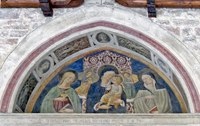
This fresco in the lunette over the entrance to the nunnery, which is signed and dated, is the earliest that can be securely attributed to Pierantonio Mezzastris. It was originally under a roof supported by four columns at the entrance to the newly completed wing of the nunnery, and was placed here during the rebuilding of 1928.
Interior of the Church
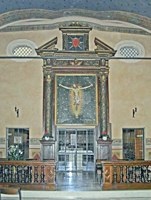
The church is in the form of three vaulted bays, with a grill in the back wall that opens onto the nuns' choir.
Crucifixion with saints (15th century)
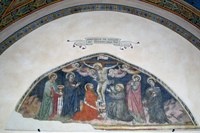
This detached fresco on the 1st bay on the right might have come from the nuns’ original church. It depicts the Crucifixion with:
-
✴the Virgin and SS Lucy on the left;
-
✴SS John the Evangelist and Clare on the right; and
-
✴SS Mary Magdalene and Francis kneeling at the foot of the Cross.
Altarpieces (17th century)
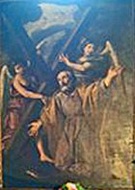
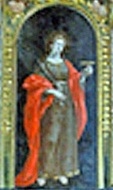
Two altarpieces in Santa Lucia are attributed to Giovanni Battista Michelini, albeit that they have been partially over-painted. They depict
-
✴St Andrew, with angels carrying the cross on which he will be crucified (on the altar on the left ); and
-
✴St Lucy, holding her eyes on a plate and a palm of martyrdom (in the 2nd bay).
Works of Art from the Complex
The following works from the nunnery of Santa Lucia are now in the Pinacoteca Civica:
Stigmatisation of St Francis (15th century)
Madonna and Child Enthroned (16th century)
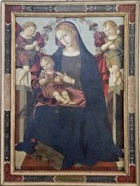
Read more:
A. Horowski (Ed.), “All’ Ombra della Chiara Luce”, (2005) Rome contains two articles relevant to Santa Lucia:
A. Bartolomei Romagnoli, “Il Francescanesimo Femminile dalle Origini al Concilio di Trento”, pp 11-85; and
M. Sensi, “I Monasteri e Bizzocaggi dell’ Osservanza Francescana nel Secolo XV a Foligno”, pp 87-175
Return to the page on Monuments of Foligno
Return to Other Nunneries in Foligno
Return to Walk I


